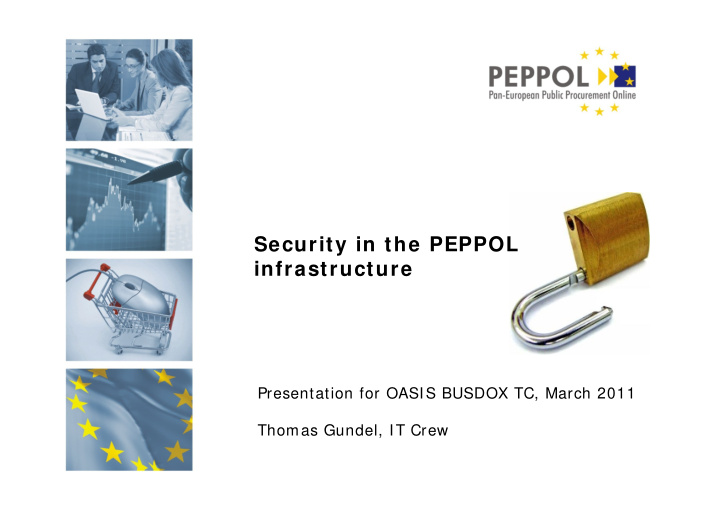



Security in the PEPPOL infrastructure Presentation for OASIS BUSDOX TC, March 2011 Thomas Gundel, IT Crew
Agenda PART I Security goals in PEPPOL Scope and requirements Security overview PART II Trust models Authentication assurance Secure communication Operational security requirements PART III Attacks and mitigations
S ecurity Goals E nable confidence and faith in the infrastructure by setting high security standards E stablish a common minimum-level of security in the PE PP OL infrastructure across organizations and countries Prevent fraud and security incidents
S cope of infrastructure security Infrastructure security scope: Communication to/from AP / SMP / SML i.e. (not end - to - end) Independent of payload Sender authentication Outside of scope: Document or Business level security: Between sender and receiver (end - to - end) Requirements for payload (e.g. signed and/or encrypted documents)
Infrastructure S ecurity Overview Security rests on five pillars: Trust via a Public Key Infrastructure Ensuring service providers sign an agreement before they join th e infrastructure Agreement regulate responsibilities, requirements, liability Checks for compliance may be performed Using secure communication protocols Employs encryption, signing, certificates, security tokens Operational security requirements for service providers Firewalls, intrusion detection, patching, logging, penetration t est Sender authentication Sender Access Point vouches for sender identity
Trust How do service providers know whether communicating peers are valid members of P E PPOL? For example, if a received message is from a valid PEPPOL Access Point? Is metadata signed by a P E PPOL S ervice Metadata P ublisher? Different trust mechanisms have been considered: a) Establish a PEPPOL PKI b) Publish Trusted Parties Lists c) Establish a service where trusted service providers can be looked up
Trust via P E PPOL P KI A public key infrastructure can be established by: A Certificate Authority issuing digital certificates under a central PEPPOL root certificate Anyone with a PEPPOL certificate is considered a valid member of the infrastructure (closed user group PKI) The PEPPOL Governing Board acts as Registration Authority
Trust via P E PPOL P KI Advantages: The C A service can be acquired as a standard offering by PKI vendors S ervice providers can validate peers just by installing the PE PP OL root certificate (does not need to invoke services) Validation of certificates is offered out-of-the-box by most middleware S cales well Proven technology E asy to revoke members R easonable cost (centralized)
Linking Trust and Agreements S ervice Providers can only join the infrastructure (and receive a PE P POL certificate) once they have signed the relevant agreements with the PE PPOL Governing Board. When entering the agreement, service providers commit to fulfill the stated quality and security requirements. The PE PPOL Governing Board may perform checks on new S ervice Providers including review of documentation, review of auditor statements on compliance etc.
S ecure C ommunication We want to achieve the following properties for secure communication in the infrastructure: Authentication Who sent a document? Integrity Has the contents been altered? Is it correct? C onfidentiality Can outsiders learn the content?
S ecure C ommunication (2) S ecure communication is achieved by: S igning S OAP messages (WS -S ecurity) Authentication of service providers Message integrity Using transport-layer security (S S L / TLS ) Confidentiality & integrity Including S AML tokens vouching for sender identity (WS - S ecurity) Sender authentication S imilar to OIO Identity-Based Web S ervices
S ender authentication S ender Access Point is required to authenticate sender of document and vouch for the identity to the recipient Recipient is relieved from the complexity of handling many diffe rent types of credentials Recipient needs only to know sender identity not details of their credential Sender Access Points have business relationships with their cust omers and should know how to authenticate them (may e.g. have issued their credential)
S ender authentication (2)
S ender authentication (3) Sender Access Point issues SAML 2.0 token stating: Sender Identity (result of authentication) Level of identity assurance (1 - 4) Issuer of token (signed with PEPPOL certificate) Level of identity assurance: 1 => low confidence in claimed in identity 4 => very high confidence in claimed identity Technology Agnostic Assurance level classified according to Liberty Alliance Identit y Assurance Framework Takes into account: The technical quality of the credential The credential issuing process Organizational factors Discussion with S TOR K project to align (eID focused)
Operational security req. Goal: ensure that service providers operate their it - systems in a secure and controlled manner Security requirements are an annex to the agreement service prov iders sign with the PEPPOL Governing Board Example requirements: Requirement for information security programme Use of digital certificates (PEPPOL PKI), revocation checks Allowed cryptographic algorithms and key lengths Incident reporting Penetration testing Firewalls and network segmentation Logging Patching and vulnerability scanning Surveillance and intrusion detection
Attacks and mitigations DNS poisoning DNSSEC can be used Registering signed top - level response Denial of service attacks Hard to guard against (needs cooperation from ISPs) R obustness and scalability of DNS helps with S ML Individual Access P oints and S MP must work with their IS Ps R ogue PE PPOL certificates: impersonate AP or S MP Liability for mis - use of your private key Operational security requirements (e.g. document key management procedures) Certificate revocation
Recommend
More recommend